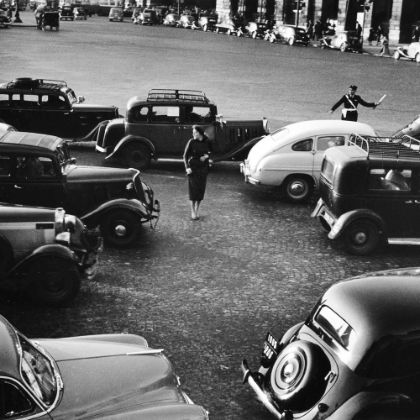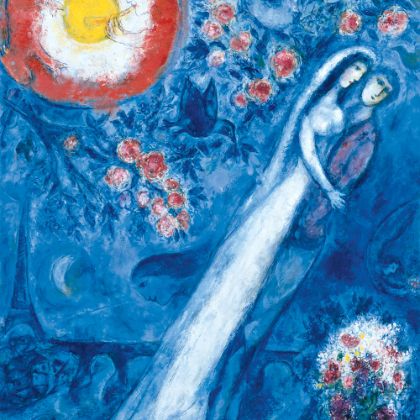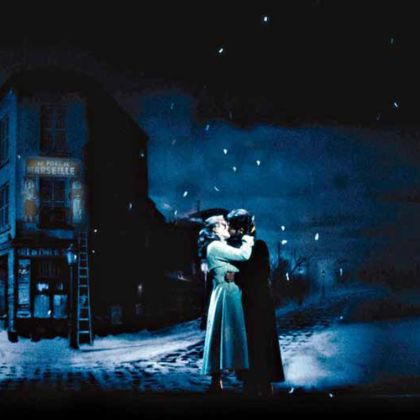An Existential Joy
Thoughts from violinist Leonidas Kavakos
on Beethoven and folk music
By Ben Finane
Leonidas Kavakos is a true third-generation violinist. His grandfather played violin and lute and led his own folk band in Greece. His father began playing in the band but was then sent to conservatory to learn classical violin. “In folk music, you play the fiddle in front of your chest — it’s a whole different approach,” explains Kavakos, a native Athenian. “My grandfather saw the technique my father was learning at the conservatory in Athens and thought, ‘My God, my son will see me play and the conservatory will teach him other things — he will become confused!’ so he stopped playing altogether. This was very moving for me.” Kavakos’s recordings include the (three) Brahms violin sonatas with pianist Yuja Wang (Decca), but when the violinist spoke to Listen at New York City’s Steinway Hall he had Beethoven on the brain, having just performed a complete survey of Beethoven’s (ten) violin sonatas with pianist Enrico Pace (also available on Decca) in three concerts across the street at Carnegie Hall.
Playing all the Beethoven violin sonatas together, what discoveries did you make?
It’s an incredible journey each and every time — an X-ray of Beethoven’s DNA. You have ten pieces, written over not such a long period. However, they are as different — and the evolution is as dramatic — as one can imagine. All the talent is revealed, in terms of Beethoven’s unlimited potential in improvisation.
And then you have the coexistence of some of the most lyrical moments — where Beethoven writes in a Schubertian manner, very melodically — juxtaposed with what you might call the identity card of Beethoven: this great drama, wherein contradictory emotions are painfully fighting against each other. For instance, if you look at Op. 24 and 25, the ‘Spring’ Sonata and the No. 4, you have two different worlds. Op. 24 is restless, breathless, agonizing; there’s a kind of agitation in the music that does not exist in the tranquil ‘Spring’ Sonata.
And then there is the enormous and incomparable mind of Beethoven, which interferes with the concept of the form. Three-movement sonatas become four-movement sonatas and then he suddenly arrives at the ‘Kreutzer,’ which is a sonata and yet nothing like a sonata. And you have the Op. 96, which looks forward to his late quartets and late symphonies, music that is classical yet still sounds contemporary today.
Improvisation is something many listeners wouldn’t think of vis-à-vis Beethoven.
We can see Beethoven’s talent for improvisation in the movements where he writes the variations. The contradiction in Beethoven is that everyone knew he was a fantastic improviser at the piano, yet his manuscripts look like warzones! Because everything he has is battling each other. Whereas Mozart was a great improviser —
— with pristine scores.
It’s like there was no other thing to write, and Mozart just wrote the greatest music. But with Beethoven, he’s fighting to achieve that (and he does). Beethoven has the ability, he has a fresh approach, and he can also see one idea in many ways. Imagine one color that can look different, without really changing, depending on how you conceive it: a blue with one million blues inside.
And such an important part of Beethoven’s legacy, obviously, is this development of ideas.
Whatever he touched... went well! The title of these works is ‘Sonata for Piano and Violin.’ Can you say this is the case for the ‘Kreutzer’ Sonata? The ‘Spring’ Sonata? Here, for the first time, he gives the theme to the violin. That’s a huge step for that day and time.
Do you bring your folk sensibility to all of classical music or does it depend on the work?
The role of folk music has always been fundamental in classical music. The role of dance can have fantastic meaning. Consider that in Greece, the folk dance is in a circle and you hold the people that you dance with. The circle symbolizes an orbit, which comes from the universe. These are projections of cosmic constants expressed through music — we don’t know why they are expressed this way, but they are.
It’s not just about the tunes. We need to understand that folk music is a very pure and instinctive approach by people who do not consider music the way we professionals see it. For them, it is something that is part of their existence, but not necessarily a part they have studied and learned — it just happens. I feel it is like the root of a tree: we don’t see the roots, but we know they’re there.
What is the greatest joy to a folk musician in a band? The first is the change of harmony. When will the leader make the turn, so that everybody follows and something changes? And, because they usually play gigs, the greatest joy for the musicians — and it’s a very existential joy — is that the pace is kept. How do you keep the pace? The right rhythm. You want to create that good mood; people will get up and dance. People will feel regenerated with energy and will need to get it out of their system — and they will dance!
And this is everywhere in classical music. The moment you ignore rhythm and harmony, you are not doing anything. Even if you are playing the notes perfectly, it means nothing. It’s like a computer that has all the data inside but doesn’t know how to use it. But the mind is the guiding force that is going to bring the data together and make it into something.
So everywhere in classical music, one way or another, folk music is involved. And if it’s not folk music, it’s religious music. Because we are human: we cannot get out of this. Take melody, for instance: a long melody, you cannot swing it. It becomes like a long, straight line. A straight line has no memory, and memory always works in cycles. The moment you start circling, memory kicks in. So if the melody is played in a flat way, then you can’t swing it, which is to say you cannot define the length, define the important points. How many important points are there in, say, a melody of four bars? Maybe one, maybe two, maybe three. It could be two and a half — but this half is combined with something that begins right after it. So if one does not put this forward, as an interpreter, then the melody for the listener is something that has no identity. This is a morbid example, but in the hospital, as long as the patient is alive, the line goes up and down. A flat line means the life is over. And this is exactly the same thing with music. It’s an energy.
A pulse.
Pulse, swing, a metric structure. Even if there’s no rhythm, there is a metric approach. Unfortunately, this is something that I feel in the modern teaching of music is lacking. We approach classical music like it’s something extremely serious. The approach should be serious. Classical music itself is beyond serious.

related...
-

Respighi: Beyond Rome
Respighi’s set of variations is cast away for his more
Read More
‘Roman’ repertoire.
By David Hurwitz -

L’amico Fritz
Mascagni delivers beautiful music, libretto be damned.
Read More
By Robert Levine -

A Simple Love Story
It’s no accident that Puccini’s La bohème remains the most performed opera.
Read More
By Robert Levine